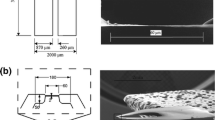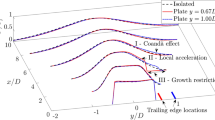Abstract
A detailed procedure to use a constant-voltage anemometer (CVA) for the accurate measurement of turbulent flows is proposed. The procedure is based on the usual small-perturbation analysis of hot-wire signals. It consists in three steps: (1) the calibration of internal elements, required to estimate the two main electrical parameters of the CVA circuitry that are needed in the data analysis, (2) a flow calibration to relate the CVA output voltage and the hot-wire time constant to the flow velocity, and (3) a data-processing algorithm to recover the fluctuating flow quantities from the output voltage. The procedure is tested in two classical turbulent flows: a zero-pressure-gradient boundary layer and a round jet. In both cases, the CVA results are shown to be essentially indistinguishable from the results obtained with a research-grade constant-temperature anemometer.





















Similar content being viewed by others
References
Bailly C, Comte-Bellot G (2015) Turbulence. Springer, Berlin
Bendat JS, Piersol AG (2010) Random data: analysis and measurement procedures, 3rd edn. Wiley, New York
Berson A, Blanc-Benon P, Comte-Bellot G (2009) A strategy to eliminate all nonlinear effects in constant-voltage hot-wire anemometry. Rev Sci Instrum 80(4):045102
Berson A, Poignand G, Blanc-Benon P, Comte-Bellot G (2010) Capture of instantaneous temperature in oscillating flows: use of constant-voltage anemometry to correct the thermal lag of cold wires operated by constant-current anemometry. Rev Sci Instrum 81(1):015102
Bruun HH (1995) Hot-wire anemometry: principles and signal analysis. Oxford University Press, Oxford
Collis D, Williams M (1959) Two-dimensional convection from heated wires at low reynolds numbers. J Fluid Mech 6(03):357–384
Comte-Bellot G (2007) Thermal anemometry. In: Tropea C, Yarin AL, Foss JF (eds) Handbook of experimental fluid mechanics. Springer, Berlin, pp 229–283
Comte-Bellot G, Sarma GR, Faure T, Dussauge JP, Dupont P, Debiève JF (1999) Performance studies of the constant voltage anemometer in a Mach 2.3 boundary layer. In: 18th international congress on instrumentation in aerospace and simulation facilities, Toulouse, France, vol paper 40
Comte-Bellot G, Weiss J, Béra JC (2004) Lead-resistance effects in a constant voltage anemometer. Rev Sci Instrum 75(6):2075–2081
De Graaff DB, Eaton JK (2000) Reynolds-number scaling of the flat-plate turbulent boundary layer. J Fluid Mech 422:319–346
Freymuth P, Fingerson LM (1997) Hot-wire anemometry at very high frequencies: effect of electronic noise. Meas Sci Technol 8(2):115–116
Horowitz P, Hill W (1989) The art of electronics, vol 2. Cambridge University Press, Cambridge
Hussein HJ, Capp SP, George WK (1994) Velocity measurements in a high-reynolds-number, momentum-conserving, axisymmetric, turbulent jet. J Fluid Mech 258:31–75
Hutchins N, Monty J, Hultmark M, Smits A (2015) A direct measure of the frequency response of hot-wire anemometers: temporal resolution issues in wall-bounded turbulence. Exp Fluids 56(1):1–18
Kegerise MA, Spina EF (2000a) A comparative study of constant-voltage and constant-temperature hot-wire anemometers Part I: the static response. Exp Fluids 29(2):154–164
Kegerise MA, Spina EF (2000b) A comparative study of constant-voltage and constant-temperature hot-wire anemometers: Part II: the dynamic response. Exp Fluids 29(2):165–177
Ligrani PM, Bradshaw P (1987) Subminiature hot-wire sensors: development and use. J Phys E Sci Instrum 20(3):323–332
Mangalam S, Sarma G, Kuppa S, Kubendran L (1992) A new approach to high-speed flow measurements using constant voltage anemometry. In: AIAA 92-3957, 17th Aerospace ground testing conference
Mohammed-Taifour A, Schwaab Q, Pioton J, Weiss J (2015) A new wind tunnel for the study of pressure-induced separating and reattaching flows. Aeronaut J 119(1211):91–108
Perry AE (1982) Hot-wire anemometry. Oxford University Press, Oxford
Sadeghi A (2014) Investigation of the frequency response of constant voltage anemometers in turbulent flows. Master’s thesis, École Polytechnique de Montréal
Sarma G, Comte-Bellot G, Faure TM (1998) Software corrected hot wire thermal lag for the constant voltage anemometer featuring a constant bandwidth at the selected compensation setting. Rev Sci Instrum 69(9):3223–3231
Sarma GR (1998) Transfer function analysis of the constant voltage anemometer. Rev Sci Instrum 69(6):2385–2391
Sarma GR, Comte-Bellot G (2002) Automated constant voltage anemometer for measurements with fluid temperature drifts. Rev Sci Instrum 73(3):1313–1317
Sarma GR, Lankes RW (1999) Automated constant voltage anemometer with in situ measurements of overheat and time constant of the hot wire. Rev Sci Instrum 70(5):2384–2386
Smits AJ, McKeon BJ, Marusic I (2011) High-reynolds number wall turbulence. Annu Rev Fluid Mech 43:353–375
Truzzi GE, Sarma GR, Chokani N (2002) Constant voltage anemometer operated hot wire at subsonic speeds over wide overheats in unsteady flows. Rev Sci Instrum 73(12):4363–4368
Weiss J (2003) Effect of bridge imbalance on the estimation of sensitivity coefficients for constant-temperature hot-wire anemometers. Meas Sci Technol 14(8):1373–1380
Weiss J, Comte-Bellot G (2004) Electronic noise in a constant voltage anemometer. Rev Sci Instrum 75(5):1290–1296
Weiss J, Knauss H, Wagner S (2001) Method for the determination of frequency response and signal to noise ratio for constant-temperature hot-wire anemometers. Rev Sci Instrum 72(3):1904–1909
Weiss J, Chokani N, Comte-Bellot G (2005) Constant-temperature and constant-voltage anemometer use in a mach 2.5 flow. AIAA J 43(5):1140–1143
Weiss J, Berson A, Comte-Bellot G (2013) Investigation of nonlinear effects in constant-temperature anemometers. Meas Sci Technol 24(8):085,302
Acknowledgments
The authors are grateful to Arun and Siva Mangalam from Tao Systems Inc. for providing a CVA unit and for their technical support. Part of this project was financed by the Samuel-De Champlain program established between the ministère des Relations internationales du Québec and the ministère des Affaires étrangères et européennes de la République française, 63rd session of the Commission permanente de coopération franco-québécoise.
Author information
Authors and Affiliations
Corresponding author
Rights and permissions
About this article
Cite this article
Mohammed-Taifour, A., Weiss, J., Sadeghi, A. et al. A detailed procedure for measuring turbulent velocity fluctuations using constant-voltage anemometry. Exp Fluids 56, 174 (2015). https://doi.org/10.1007/s00348-015-2045-0
Received:
Revised:
Accepted:
Published:
DOI: https://doi.org/10.1007/s00348-015-2045-0




